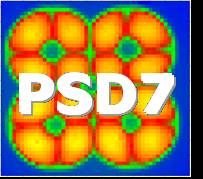Speaker
Dr
Spyros Manolopoulos
(CLRC-RAL)
Description
The microstrip detector is the workhorse of position sensitive
detectors for tracking in particle physics experiments. Spatial
resolution of a few m is easily achieved at read-out rates of few
MHz. Utilising modern fabrication techniques (photolithography and
ion implantation) provides with reliable and versatile devices with
designs that can be tailored to meet the demands of different and
diverse applications where PSD's are in demand, ranging from medical
dosimetry to beam line monitoring in synchrotrons. To that extend we
build a silicon microstrip detector around the XCHP ROIC originally
developed for SR experiments. This comprises of a series of charge
sensitive preamplifiers (128 of) working on integrating mode with on
chip multiplexing and correlated double sampling (CDS). Now
commercially available by ETL as part of XDAS, it provides with a
complete, versatile and low cost PC based DAQ system. The use of
multileaf collimators (MLC) in modern radiotherapy techniques like
IMRT requires dynamic measurements in the presence of high dose
gradients. This requires a dynamic range dosimeter with sub-
millimetre spatial resolution as well as high linearity. In addition,
real time measurements will be beneficial to the QA procedures of
modern LINACs. Preliminary trials of our prototype microstrip
detector at the Weston Park Hospital in Sheffield (UK) produced very
encouraging results showing a film like penumbra (Figure 1). Further
results of the detector's evaluation as PS dosimeter for IMRT and
from experiments with other radiotherapy modalities, like the
synchrotron based Microbeam Radiation Therapy (MRT) will be
presented.
In addition, results will be presented with its use as beam position
monitoring device in synchrotron experiments. This is very important
with the ever decrease in sample and beam size accordingly, which
imposes severe constrain in beam focus and stability especially for
measurements that require long acquisition times, as any drift will
be detrimental or at worst catastrophic for the data quality.
Primary author
Dr
Spyros Manolopoulos
(CLRC-RAL)




